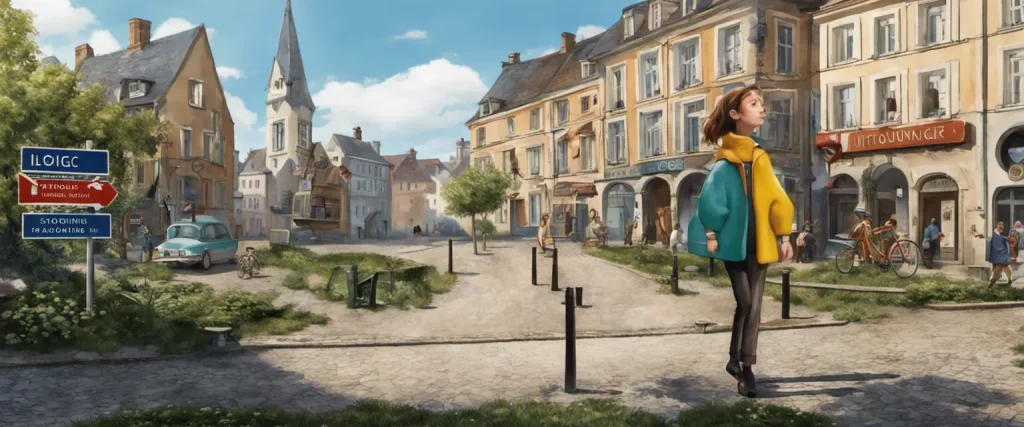In “Sophie’s World” by Jostein Gaarder, a teenage girl named Sophie Amundsen begins to receive mysterious letters that lead her on an extraordinary philosophical journey. Written by the Norwegian author Jostein Gaarder, this thought-provoking novel takes readers on a captivating exploration of the history of philosophy, blending fiction with philosophy to create an engaging narrative that challenges our understanding of the world and ourselves. Gaarder, a renowned philosopher and novelist, is known for his ability to seamlessly merge complex philosophical concepts with compelling storytelling, making “Sophie’s World” a timeless classic that has captivated readers worldwide.
Chapter 1: The World of Sophie
Chapter 1: The World of Sophie in the book Sophie’s World by Jostein Gaarder introduces us to the protagonist, Sophie Amundsen, a fourteen-year-old girl living in Norway. The chapter explores the main theme of the novel, the philosophy of life, by taking us into Sophie’s world.
The chapter begins with Sophie arriving home from school and finding a mysterious white envelope addressed to her. Curious, Sophie opens it to find a single question: “Who are you?” This simple question triggers Sophie’s journey into the world of philosophy.
As the story progresses, Sophie starts receiving more envelopes containing philosophical questions. These questions challenge her understanding of life, existence, and reality. Sophie soon realizes that her world is not as ordinary as she thought.
The chapter also introduces Alberto Knox, a philosopher and Sophie’s mentor throughout the book. He teaches Sophie about the history of philosophy and starts explaining different philosophical concepts to her through written notes.
Sophie learns about the Ancient Greeks and their ideas about the nature of the world, and she discovers that philosophers throughout history have sought to understand the fundamental questions of life. Philosophy becomes Sophie’s passion, as she grapples with existential questions such as “Who are we?” and “Why are we here?”
By the end of Chapter 1, Sophie begins to understand that her world is not confined to her physical surroundings, but extends beyond into the realm of ideas and thoughts. She embarks on an intellectual and philosophical journey, eager to explore and make sense of the vast universe of human knowledge.
Chapter 1 sets the stage for Sophie’s philosophical odyssey, igniting her curiosity and pushing her to delve deeper into the mysteries of existence and the vast world of ideas.
Chapter 2: The Garden of Eden
Chapter 2: The Garden of Eden in Sophie’s World by Jostein Gaarder serves as an introduction to the theories of natural philosophers from ancient Greece, focusing specifically on the philosophers Thales, Anaximander, and Anaximenes. The chapter explores the ideas of these philosophers and their interpretations of the world around them.
The chapter begins with Sophie, the book’s protagonist, being introduced to Thales, the first philosopher. Thales proposed that water was the fundamental element from which all things originated. He believed that everything in the world was ultimately composed of water. Sophie learns about Thales’ ideas through her mysterious and philosophical mentor, Alberto Knox. Alberto engages Sophie in thought-provoking conversations, challenging her to question her own understanding of the world.
Next, Sophie delves into the teachings of Anaximander, who suggested that the fundamental element was “the Boundless” or an undefined substance. Anaximander believed that everything emerged from this primordial substance and returned to it eventually. He discussed the concept of evolution and the cyclical nature of life, which Sophie finds intriguing.
Lastly, the chapter introduces Anaximenes, who believed that air was the primary element in existence. He claimed that air could transform into different forms, such as fire and water, thereby influencing the creation and destruction of all matter.
Throughout the chapter, Sophie grapples with understanding these different philosophical perspectives and begins to question her own beliefs about the nature of reality. Gaarder uses this chapter to lay the groundwork for the exploration of more complex philosophical ideas within the narrative, opening the reader’s mind to the rich variety of thoughts and theories that have shaped our understanding of the world.
Chapter 3: The Natural Philosophers
Chapter 3 of Sophie’s World, titled “The Natural Philosophers,” explores the ancient Greek philosophers who laid the foundation for modern science and philosophy. Sophie receives another envelope in her mailbox, which contains notes and a postcard from the philosopher Democritus.
The chapter begins with the teachings of Thales of Miletus, who believed that everything had a scientific explanation and sought to understand the order in nature. Anaximander, a student of Thales, believed that the essential substance of the world was not any specific element but an unknown, indefinite substance. Anaximenes, another disciple of Thales, hypothesized that the essential substance was air which, through condensation and rarification, could transform into other elements such as water or fire.
Heraclitus, known for his paradoxical statements, believed that the only constant in life was change. Parmenides, on the other hand, argued that change was an illusion and that reality was an unchanging, eternal being.
The chapter then introduces the philosopher Empedocles, who proposed that all matter consisted of four basic elements: earth, air, fire, and water. He believed that these elements constantly mixed and separated, leading to the creation and destruction of all things.
Sophie learns about the life and teachings of Anaxagoras, the first to introduce the concept of a mind or intelligence governing the universe. Anaxagoras believed that everything contained a fraction of the divine intelligence, which controlled the order and processes of the natural world.
Finally, Democritus is introduced, who developed the atomistic philosophy. Democritus believed that everything in the world consisted of tiny, indivisible particles called atoms, which had different shapes and arrangements. He argued that the interactions between these atoms explained the essence, properties, and changes in all matter.
Overall, Chapter 3 explores the contributions of ancient Greek philosophers who sought to understand the natural world through observation, reason, and logic, laying the groundwork for the development of science and philosophy that continue to influence our understanding today.
Chapter 4: The Classical Philosophers

Chapter 4: The Classical Philosophers of Sophie’s World by Jostein Gaarder delves into the ideas and thoughts of three prominent classical philosophers: Socrates, Plato, and Aristotle. The chapter explores the intriguing intertwining lives of these ancient scholars and how their philosophies shaped the course of history.
The chapter begins by introducing Socrates, the father of Western philosophy. Socrates believed that genuine knowledge could only be attained through dialogue and questioning. He embraced the Socratic method, engaging in conversations with people to challenge their beliefs and unearth deeper truths. Socrates’ relentless pursuit of knowledge eventually led to his trial and subsequent execution.
Plato, Socrates’ most well-known student, is the next philosopher examined in the chapter. Plato created a distinctive realm of ideals, asserting that the true reality lies beyond our senses. He believed that the physical world is merely a reflection of that higher realm. Plato emphasized the existence of an immortal soul and the importance of education in developing philosophical thinking.
Lastly, the chapter explores the contributions of Aristotle, another significant philosopher and Plato’s student. Aristotle took a different approach from his predecessors, focusing on empirical observation and rationality. He classified and analyzed the natural world, providing a foundation for mathematics, biology, and physics. Aristotle also introduced the concept of the “Golden Mean,” advocating for moderation in all aspects of life.
Throughout the chapter, Gaarder intertwines the teachings of these renowned thinkers with the narrative of the story itself. Sophie, the novel’s protagonist, learns about their philosophies from her mysterious philosopher tutor, Alberto Knox. Together, they explore the depth and complexity of classical philosophy, juxtaposing ancient ideas with modern questions and reflections.
In summary, Chapter 4 of Sophie’s World delves into the lives and philosophies of Socrates, Plato, and Aristotle, exploring their innovative ideas and the impact they had on the world of philosophy and beyond.
Chapter 5: The Renaissance
Chapter 5: The Renaissance of Sophie’s World by Jostein Gaarder starts with a letter from Sophie’s philosopher mentor, Alberto, that transports her back to the time of the Renaissance. In this chapter, Sophie learns about the cultural and intellectual movement that swept through Europe during the 14th to the 17th centuries and had a profound impact on various fields such as art, science, and philosophy.
Alberto explains to Sophie that the Renaissance was characterized by a renewed interest in the humanistic values of Ancient Greece and Rome and a shift in focus from the divine to human beings. During this time, there was a revival of classical literature, art, and culture, which led to a shift in the perception of the individual’s role in society.
Alberto takes Sophie to a vibrant and bustling Renaissance fair, where she encounters various historical figures like Michelangelo, Leonardo da Vinci, and Copernicus. Sophie learns about the groundbreaking art created during this period, such as Michelangelo’s David and Leonardo’s Mona Lisa, which showcased the human body and emotions in incredible detail. She also discovers that the Renaissance thinkers challenged the dominant beliefs of the Middle Ages through scientific discoveries, like Copernicus’ heliocentric model of the solar system.
Through these encounters, Sophie realizes that the Renaissance was a breakthrough period that celebrated the potential of human beings and their abilities to question and explore the world around them. The focus on reason, individualism, and human potential helped set the stage for the Enlightenment and the emergence of modern science and philosophy.
As the chapter concludes, Sophie receives another letter from Alberto, teasing her about the upcoming exploration of the Enlightenment period, where she will learn about thinkers like Descartes and Kant who further shaped the course of human thought.
Chapter 6: Enlightenment
Chapter 6 of Sophie’s World, titled “Enlightenment,” delves into the ideas and philosophies of the Enlightenment period. It begins with Sophie receiving a letter that contains three documents: a page torn from a textbook about the Enlightenment, a newspaper clipping about the French Revolution, and a letter intended for Hilde, the book’s mysterious recipient.
As Sophie reads the page from the textbook, she learns about the Enlightenment thinkers, who believed in the power of reason and criticized the authority of the church and absolute monarchies. Sophie becomes intrigued by the ideas of René Descartes, who emphasized doubt and skepticism as a means of arriving at truth.
She then reads about a pivotal event during the Enlightenment, the French Revolution. This leads her to reflect upon the concept of equality and the fight against injustice and oppression that characterized this period. Sophie begins to see connections between the Enlightenment and her own world, recognizing how calls for freedom and equality still resonate in modern society.
The chapter concludes with Sophie shifting her focus to the accompanying letter meant for Hilde. The letter is addressed to a Major Albert Knag and contains a cryptic message suggesting that Hilde’s father knows about the philosophical journey Sophie is undertaking. Sophie is left wondering about the intentions behind this letter, as well as the connection between her own experiences and those of Hilde.
In this chapter, Gaarder provides a concise overview of the Enlightenment, emphasizing its key ideas and historical context while simultaneously raising questions as to its relevance in the broader narrative of the story.
Chapter 7: Romanticism
Chapter 7 of Sophie’s World by Jostein Gaarder explores the philosophical movement known as Romanticism. In this chapter, Sophie receives a new philosophical question from her mysterious mentor, Alberto Knox, and delves into the concepts and ideas associated with Romanticism.
The chapter begins with a discussion of the historical context of Romanticism, which emerged in the late 18th century as a reaction against the Age of Enlightenment. Romanticism celebrated emotions, imagination, and individuality, focusing on the beauty and power of nature, as well as the mysteries of the human soul.
Alberto introduces key figures of the Romantic movement, including German poets Johann Wolfgang von Goethe and Friedrich Schiller. Sophie learns about Goethe’s novel “The Sorrows of Young Werther,” which depicts the protagonist’s struggle with unrequited love and his eventual decision to take his own life. This novel exemplifies the Romantic fascination with individual emotional experiences and the exploration of the darker aspects of human existence.
Furthermore, the chapter discusses the connection between Romanticism and the sublime. Sophie ponders the idea of the sublime as a feeling of awe and fear that arises when experiencing nature’s grandeur. For Romantics, the sublime represented a way to transcend the mundane and connect with something greater than themselves.
Sophie also explores the concept of romantic love, which involves elevated and passionate emotions. She considers the intense feelings associated with falling in love and the connection between love and art.
Overall, this chapter presents Romanticism as a philosophical movement that emphasized the importance of emotions, imagination, and the individual experience. It highlights the Romantic fascination with nature, the sublime, and love as key themes in their exploration of the human condition.

Chapter 8: Existentialism
Chapter 8 of “Sophie’s World” by Jostein Gaarder explores the philosophical school of existentialism. Sophie receives a letter from Alberto Knox, her mysterious philosophy teacher, congratulating her on completing eight weeks of their philosophy course. He tells her that the next topic they will cover is existentialism, which focuses on the individual and their freedom and responsibility in creating their own existence.
Alberto explains to Sophie that existentialists believe that life is something we each create rather than something that is determined for us. They emphasize the importance of personal choice and the freedom to make decisions, even in the face of despair and uncertainty. Sophie learns that existentialism emerged in response to the horrors and existential crises experienced during World War II, as philosophers sought to understand the meaning of life in the midst of such destruction.
As Sophie delves deeper into existentialism, she learns about the concept of “thrownness” – the idea that we are thrown into existence without choosing to be born. However, she also discovers that this thrownness does not limit one’s freedom and ability to shape their own existence. Existentialists believe that individuals are responsible for their actions and must confront the anxiety and meaninglessness of existence with authenticity.
The chapter explores the philosophy of renowned existentialist thinkers such as Søren Kierkegaard and Friedrich Nietzsche. Alberto highlights Kierkegaard’s concept of “leap of faith” and Nietzsche’s idea of the “will to power,” emphasizing the individual’s capacity to assert their own existence.
Overall, this chapter delves into the profound questions raised by existentialism, encouraging Sophie (and the reader) to reflect upon their own existence, freedom, and responsibility in shaping their lives.
After Reading
In conclusion, Sophie’s World by Jostein Gaarder takes readers on a captivating journey through the history of philosophy, feasting their minds with thought-provoking ideas and profound concepts. Through the eyes of the young protagonist, Sophie, Gaarder brilliantly combines fiction and philosophy, unraveling the mysteries of human existence and challenging conventional thinking. The book’s engaging narrative, layered with philosophical teachings, encourages readers to question their own beliefs and contemplate the meaning of life. Ultimately, Sophie’s World serves as a stimulating and enlightening read that expands the horizons of the mind, leaving a lasting impact on its audience.
1. The Story of Art” by E.H. Gombrich: An exceptional book for art enthusiasts and novices alike, Gombrich’s masterpiece offers a comprehensive exploration of the history and evolution of art. With engaging prose and accessible explanations, this book delves into various art movements, from ancient times to modern day, providing a deeper understanding and appreciation for the world of art.
2. Money Changes Everything” by William N. Goetzmann: Building on the philosophical foundation laid by Sophie’s World, “Money Changes Everything” examines the influence of financial systems and their impact on human society throughout history. Goetzmann illustrates how the evolution of money has shaped civilizations, economies, and cultures worldwide, uncovering the intricate relationship between money and humanity.
3. Albion’s Seed” by David Hackett Fischer: In this captivating historical account, Hackett Fischer explores the diverse cultural origins of the early American settlers, particularly the British migrants who formed the foundation of American society. Drawing upon meticulous research, this book offers a fresh perspective and compelling analysis of the cultural and sociopolitical differences that continue to shape the United States today.
4. Sapiens: A Brief History of Humankind” by Yuval Noah Harari: Following the thought-provoking nature of Sophie’s World, “Sapiens” takes readers on an enlightening journey through the history of our species. Harari challenges conventional wisdom, questioning the narratives on the development of Homo sapiens and humankind’s domination over the planet. Exploring cognitive revolutions, agricultural advancements, and societal changes, this book offers a captivating take on our shared human history.
5. “The Tao of Physics” by Fritjof Capra: Exploring the intersection of Eastern philosophy and modern physics, Capra’s book offers a fascinating exploration of the interconnectedness between science and spirituality. Delving into the fundamental principles of quantum mechanics and comparing them to ancient Eastern philosophies, Capra invites readers to reflect on the profound implications of these converging perspectives, ultimately broadening our understanding of reality itself.



